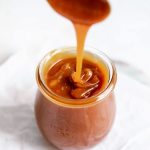 When heated until it melts and browns, sugar is called caramel, a word that literally means honey-cane: in Medieval Latin, the sugar cane plant was called cannamella, a word formed by combining canna, meaning cane, and mel, meaning honey. Cannamella then evolved into Spanish as caramelo, where it became the name of a browned sugar resembling the sweet juice extracted from sugar canes. English adopted caramelo in the early eighteenth century as caramel, first using the word as a name for browned sugar, and later as a name for a small candy made from sugar, cream, and flavouring.
When heated until it melts and browns, sugar is called caramel, a word that literally means honey-cane: in Medieval Latin, the sugar cane plant was called cannamella, a word formed by combining canna, meaning cane, and mel, meaning honey. Cannamella then evolved into Spanish as caramelo, where it became the name of a browned sugar resembling the sweet juice extracted from sugar canes. English adopted caramelo in the early eighteenth century as caramel, first using the word as a name for browned sugar, and later as a name for a small candy made from sugar, cream, and flavouring.
A confectionery delicacy that is characterized by its smooth, waxy, and chewy texture is crafted from a concoction of saccharine sucrose, rich cream, and syrup derived from cornstarch.
This passage is describing a substance that is made by heating sugar very slowly in a thick pan until it turns a dark brown color. When water is added to this substance, it produces a dark brown liquid. This substance is commonly known as “caramel”. Commercially, caramel is used as a coloring agent in a variety of food and drink products, including gravy, fruit cakes, wines, beers, vinegars, soups, sauces, and more.
